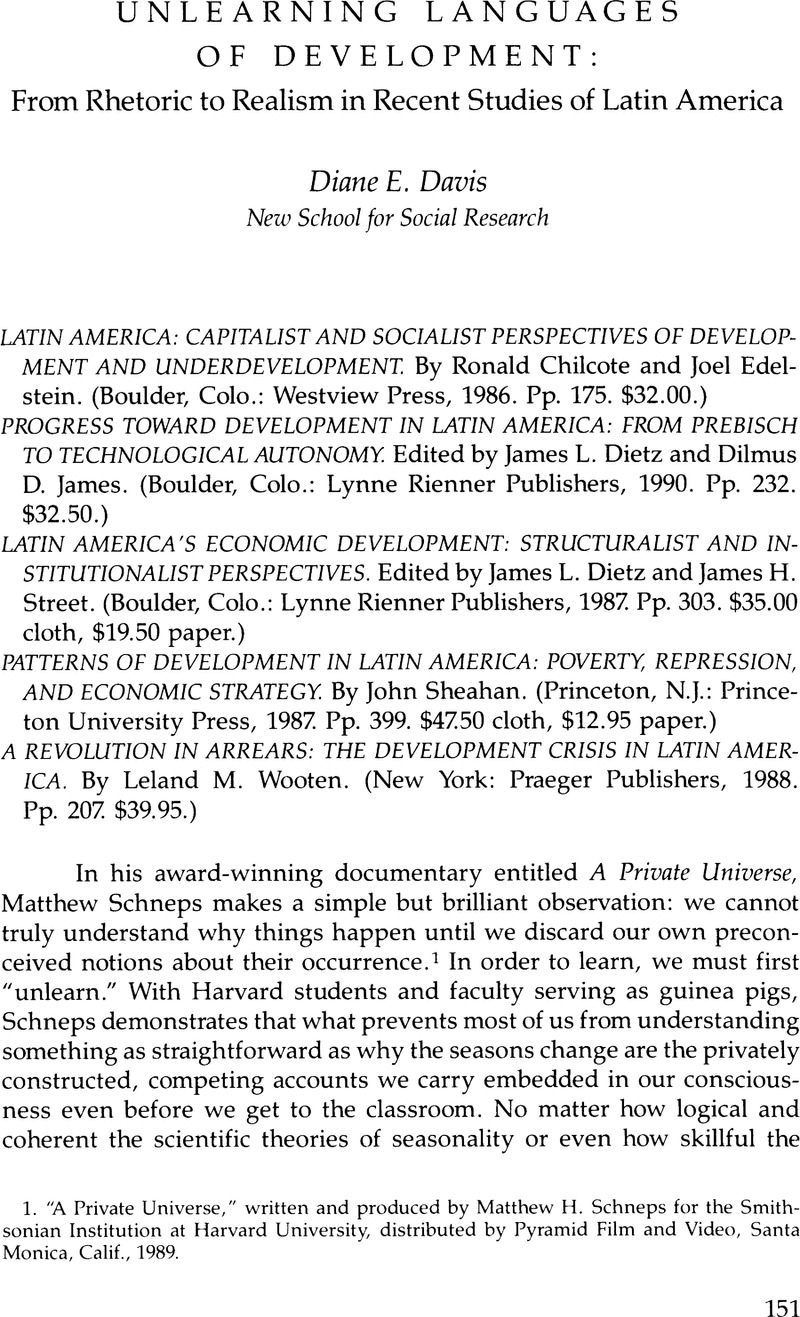Article contents
Unlearning Languages of Development: From Rhetoric to Realism in Recent Studies of Latin America
Review products
Published online by Cambridge University Press: 12 October 2022
Abstract

- Type
- Review Essays
- Information
- Copyright
- Copyright © 1992 by the University of Texas Press
References
Notes
1. “A Private Universe,” written and produced by Matthew H. Schneps for the Smithsonian Institution at Harvard University, distributed by Pyramid Film and Video, Santa Monica, Calif., 1989.
2. The prospects and possibilities of this route are detailed in Leopoldo Solis, Economic Policy Reform in Mexico: A Case Study for Developing Countries (New York: Pergamon, 1981). See also Bela Kadar, Problems of Economic Growth in Latin America (New York: St. Martin's, 1980).
3. Some of these patterns are discussed in Alejandro Foxley, Latin American Experiences in Neoconservative Economics (Berkeley and Los Angeles: University of California Press, 1983). See also Peter Evans, Dependent Development: The Alliance of Multinational, State, and Local Capital in Brazil (Princeton, N.J.: Princeton University Press, 1979).
4. I am thinking especially of Grupo Alfa and the Mexican government's Chrysler-like bailout in the late 1980s. For an overall picture of conditions that led up to this outcome, see Dale Story, “Sources of Investment Capital in Twentieth-Century Mexico” in Statistical Abstract of Latin America, 1984, edited by James Wilkie and Adam Perkal (Los Angeles: Latin American Studies Center, University of California, 1985).
5. See for example Mariluz Cortes, Success in Small and Medium-Scale Enterprises: The Evidence from Colombia (New York: Oxford University Press, 1987).
6. One of the best case-study accounts of this pattern is found in Clark Reynolds, “Why ‘Stabilizing Development’ Was Actually Destabilizing (with Some Implications for the Future),” World Development 6 (1978):1005–18.
7. Some of these problems are discussed in John K. Thompson, Inflation, Financial Markets, and Economic Development (Greenwich, Conn.: Jai Press, 1979).
8. One classic article by Albert Hirschman touched on the relationships between firm size (and family ownership) and the predominance of import-substituting industrialization. See “The Political Economy of Industrialization in Latin America,” Quarterly Journal of Economics 82, no. 1 (Feb. 1968):1–32. These issues are also discussed by Flavia Derossi in The Mexican Entrepreneur (Paris: Development Centre for the OECD, 1971).
9. For a comprehensive analysis of how this process worked in one industry, as well as its political and economic implications, see Douglas Bennett and Kenneth Sharpe, Transnational Corporations versus the State: The Political Economy of the Mexican Auto Industry (Princeton, N.J.: Princeton University Press, 1985).
10. Some of these problems are discussed in Foreign Investment, Debt, and Economic Growth in Latin America, edited by Antonio Jorge and Jorge Salazar-Carrillo (New York: St. Martin's, 1988).
11. Some of these conflicts within and between classes and the state are addressed in articles included in two recently edited volumes: Barbara Stallings and Robert Kaufman's Debt and Democracy in Latin America (Boulder, Colo.: Westview, 1989); and William L. Canak's Lost Promises: Debt, Austerity, and Development (Boulder, Colo.: Westview, 1989). For more detailed discussion of political tensions and their negative impact on economic policy and macroeconomic conditions in the context of a particular country, see Roberto Newell and Luis Rubio, Mexico's Dilemma: The Political Origins of Economic Crisis (Boulder, Colo.: Westview, 1984); or Sylvia A. Hewitt, The Cruel Dilemmas of Development: Twentieth-Century Brazil (New York: Basic Books, 1980).
12. See for example Fernando Henrique Cardoso, “Associated-Dependent Development: Theoretical and Practical Implications,” in Authoritarian Brazil: Origins, Policies, and Future, edited by Alfred Stepan (New Haven, Conn.: Yale University Press, 1973); Evans, Dependent Development; and David Becker, The New Bourgeoisie and the Limits of Dependency: Mining, Class, and Power in ‘Revolutionary’ Peru (Princeton, N.J.: Princeton University Press, 1983).
13. On corporatism, see James Malloy, Authoritarianism and Corporatism in Latin America (Pittsburgh, Pa.: University of Pittsburgh Press, 1977); and Howard Wiarda, Corporatism and National Development in Latin America (Boulder, Colo.: Westview, 1981). On state capitalism, see E. V. K. Fitzgerald, “State Capitalism in Peru: A Model of Economic Development and Its Limitation,” The Peruvian Experiment Reconsidered, edited by Cynthia McClintock and Abraham Lowenthal (Princeton, N.J.: Princeton University Press, 1983). On bureaucratic authoritarianism, see Guillermo O'Donnell, Modernization and Bureaucratic-Authoritarianism (Berkeley: Institute of International Studies, University of California, 1973).
14. To the extent that the mathematical equations dominating the work of U.S. economists can be seen as a completely different language from the qualitative discourse in Latin America, in making this point Sunkel also links his understanding of different theoretical perspectives to different languages of development.
15. My use of realist here draws on the tradition of realist philosophy that attempts to move beyond the ideographic-nomothetic (or contextualizing versus law-seeking) debate. For a discussion of the general contours of the debate, see Roy Bhaskar, Scientific Realism and Human Emancipation (London: Verso, 1986). For more specific application of the concept of realism in an empirical research setting, see A. Sayer, “The New Regional Geography and Problems of Narrative,” Environment and Planning 7 (1989):253–76.
16. Sheahan notes that in Chile, for example, the structural weaknesses of the economy today are as much due to the bullheadedness with which certain actors advocated and introduced free-market capitalism as to the continual political struggles between left and right (p. 229).
- 11
- Cited by




